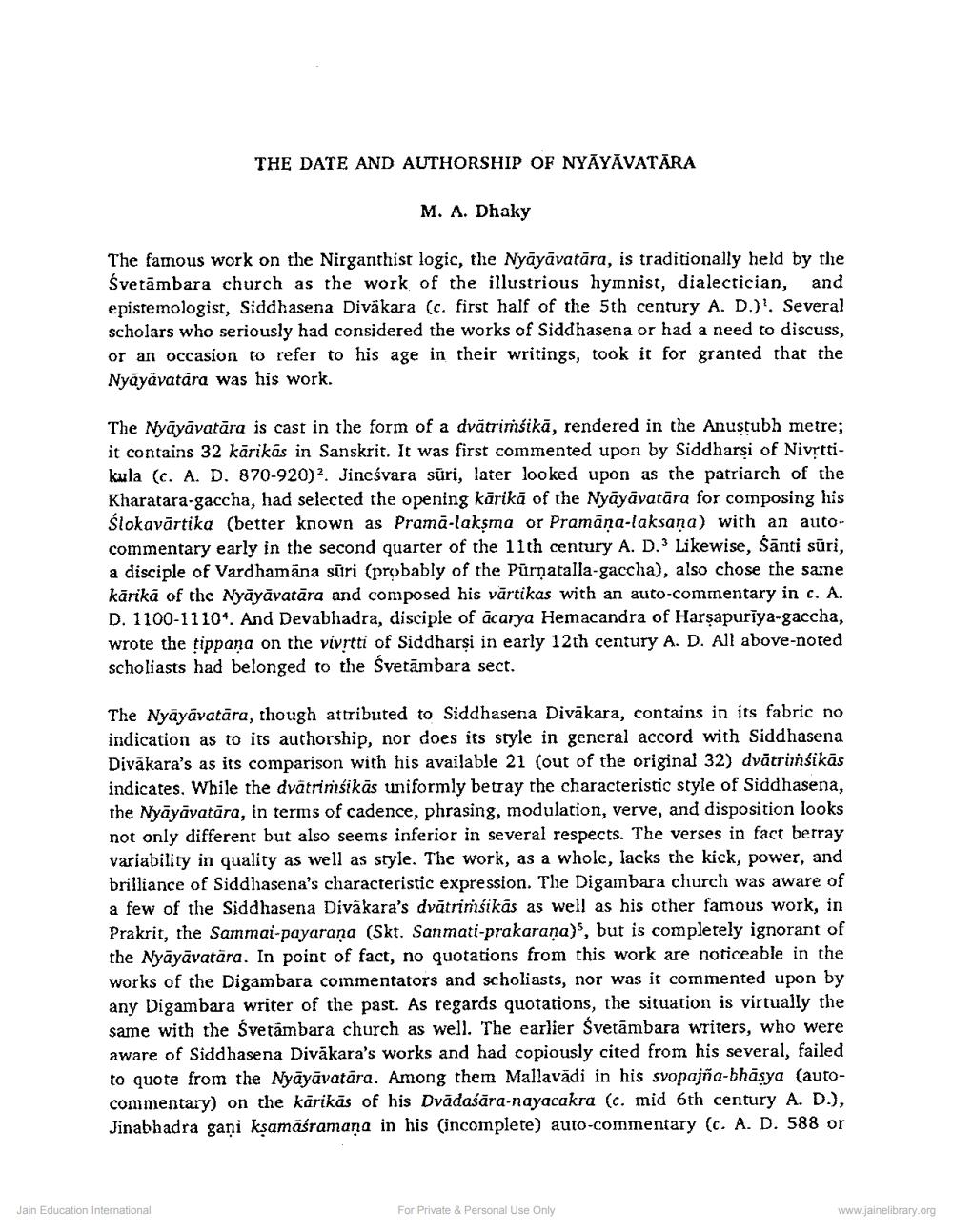Book Title: Date and Authorship of Nyayavatara Author(s): M A Dhaky Publisher: Z_Nirgrantha_1_022701.pdf and Nirgrantha_2_022702.pdf and Nirgrantha_3_022703.pdf View full book textPage 1
________________ THE DATE AND AUTHORSHIP OF NYAYAVATARA M. A. Dhaky The famous work on the Nirganthist logic, the Nyāyāvatāra, is traditionally held by the Svetämbara church as the work of the illustrious hymnist, dialectician, epistemologist, Siddhasena Diväkara (c. first half of the 5th century A. D.). Several scholars who seriously had considered the works of Siddhasena or had a need to discuss, or an occasion to refer to his age in their writings, took it for granted that the Nyayavatára was his work. The Nyāyāvatāra is cast in the form of a dvātrimśikā, rendered in the Anustubh metre; it contains 32 kārikās in Sanskrit. It was first commented upon by Siddharsi of Nivṛttikula (c. A. D. 870-920)2. Jineśvara sūri, later looked upon as the patriarch of the Kharatara-gaccha, had selected the opening karika of the Nyäyävatära for composing his Ślokavārtika (better known as Prama-laksma or Pramana-laksana) with an autocommentary early in the second quarter of the 11th century A. D. Likewise, Santi süri, a disciple of Vardhamana süri (probably of the Pürṇatalla-gaccha), also chose the same kärikā of the Nyāyāvatāra and composed his vārtikas with an auto-commentary in c. A. D. 1100-1110. And Devabhadra, disciple of acarya Hemacandra of Harsapuriya-gaccha, wrote the tippana on the vivṛtti of Siddharsi in early 12th century A. D. All above-noted scholiasts had belonged to the Svetämbara sect. The Nyayavatāra, though attributed to Siddhasena Diväkara, contains in its fabric no indication as to its authorship, nor does its style in general accord with Siddhasena Diväkara's as its comparison with his available 21 (out of the original 32) dvātrimlikās indicates. While the dvätrimisikäs uniformly betray the characteristic style of Siddhasena, the Nyäyävatüra, in terms of cadence, phrasing, modulation, verve, and disposition looks. not only different but also seems inferior in several respects. The verses in fact betray variability in quality as well as style. The work, as a whole, lacks the kick, power, and brilliance of Siddhasena's characteristic expression. The Digambara church was aware of a few of the Siddhasena Diväkara's dvātrimśikās as well as his other famous work, in Prakrit, the Sammai-payarana (Skt. Sanmati-prakarana)", but is completely ignorant of the Nyayavatara. In point of fact, no quotations from this work are noticeable in the works of the Digambara commentators and scholiasts, nor was it commented upon by any Digambara writer of the past. As regards quotations, the situation is virtually the same with the Svetambara church as well. The earlier Svetambara writers, who were aware of Siddhasena Diväkara's works and had copiously cited from his several, failed to quote from the Nyāyāvatāra. Among them Mallavadi in his svopajña-bhasya (autocommentary) on the kärikäs of his Dvādasara-nayacakra (c. mid 6th century A. D.), Jinabhadra gani kṣamäśramana in his (incomplete) auto-commentary (c. A. D. 588 or Jain Education International For Private & Personal Use Only www.jainelibrary.orgPage Navigation
1 2 3 4 5 6 7 8 9 10 11
